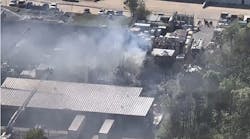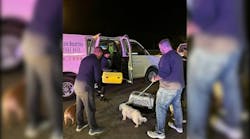College Station, TX., June 1st, 2011 — GSSI of Salem, N. H., has donated a search and rescue device, the LifeLocator III+ motion detector, to TEEX's Disaster Preparedness and Response division. The advanced motion detector will be used for both search and rescue training at Disaster City? and for Texas Task Force 1 response operations.
The LifeLocator III+ uses ground-penetrating radar to produce an image of the subsurface, allowing responders to locate live victims of catastrophic events by detecting motion or even breathing underneath building debris or collapsed structures.
"It can detect motion up to 30 feet below the surface and breathing up to 18 feet below the surface," says Ken Corcoran with GSSI. "The radar system can also indicate the distance to a live victim, and does not require silence or work stoppage," he added. The lightweight, portable radar device includes a wireless sensor and a handheld PDA control unit and can be easily deployed by a single person. LifeLocator III has been deployed in several disasters including the 2008 Sichuan earthquake in China (see photo at left) and the 2010 earthquake in Haiti. "The company has deployed over 450 units worldwide to countries such China, Israel, France and Japan," Corcoran said.
GSSI conducted a demo and field trials of the equipment in the rubble piles and collapsed structures at Disaster City in late March, said JD Bolich with the TEEX Product Development Center. The 25-pound sensor is positioned over the search area and a handheld computer is operated by the search and rescue specialist up to 50 feet away. The sensor range is a 50-footsquare area, although it cannot see through metal sheeting or metal roofing material as it disrupts its signal. Corcoran said he first learned about Disaster City from a business contact in Israel. After research on the Internet, he called TEEX and spoke with Bolich in January. Those discussions led to the demo and field trial with search team managers and Texas Task Force 1 members on March 31. Corcoran was invited back to Disaster City to demo the device at a recent Technical Search class. TEEX CEO Gary Sera accepted the GSSI donation on behalf of the agency on April 20. "We're pleased to be able to offer our students the opportunity to get first-hand experience with the latest search and rescue technologies, as well as offer companies the chance to get feedback on their products from the actual end-users," Bolich said.





